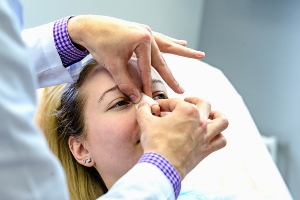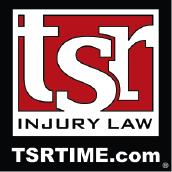Individuals who sustain facial injuries in a car crash may end up with permanent scarring and disfigurement. Even if the injury fully heals, these victims may often experience a lengthy recovery, significant pain and suffering, and a hefty financial burden they were not expecting.
This article discusses the facial injuries most common in motor vehicle crashes and when victims may be eligible to recover compensation for medical costs, including plastic surgery, lost wages and other damages.
Do you have facial fractures or other serious injuries from a car crash? If so, our experienced car crash attorneys in Minneapolis are prepared to help. Do not hesitate to contact us at TSR Injury Law to discuss your situation and learn about your legal options.
Your initial consultation is FREE. Call: (612) TSR-TIME today.
How Common Are Facial Injuries From a Car Crash?

Facial injuries from crashes are fairly common. In fact, various studies done over the last decade show as much as 50 percent or more people involved in a crash sustain some type of facial injury. It is fair to say these numbers have improved more recently due to improved vehicle safety. When crash victims suffer facial injuries, however, they are often quite severe.
What Are Some Common Facial Injuries in Vehicle Crashes?
Motor vehicle collisions may cause facial trauma due to victims striking the steering wheel, dashboard, windshield or deployed airbag. Some of the most common facial injuries include:
- Lacerations and abrasions: Deep cuts to the face can cause significant bleeding and scarring.
- Fractures: Broken facial bones may involve the jaw, cheekbones, nose or eye sockets.
- Dental injuries: Crashes can cause chipped, broken or knocked-out teeth.
- Eye injuries: Trauma to the eyes, including retinal tears or detachment, can lead to vision problems or permanent blindness without immediate surgical repair.
- Soft tissue injuries: Damage to muscles, ligaments and nerves in the face can impair movement and sensation.
- Burns: Airbag deployment or vehicle fires may cause facial burns.
Can I Include Damages Related to My Facial Injury in a Car Crash Claim?
As long as you or your attorney can prove the other party’s negligence led to the crash and your injuries, then yes, you can include facial injury damages as part of your overall car crash claim. Minnesota law allows victims to seek compensation for all injuries directly caused by a car crash.
Facial injuries often fall under “bodily injury” in insurance claims. This means they are typically covered by the at-fault driver’s liability insurance.
Where you may run into trouble is in dealing with insurance companies, as they may try to downplay injuries to your face. They might try to argue these injuries are less severe than other types of trauma.
Why Might Insurance Companies Try to Avoid Paying for Facial Injuries?
Insurance companies often try to avoid paying for facial injuries to protect their bottom line. They know these injuries can be costly and complex, potentially leading to higher payouts.
Here are some other reasons insurers might resist compensating facial injury claims:
- High medical costs: Facial injuries often require expensive treatments, like plastic surgery or dental work.
- Long-term impacts: Injuries to the face can have lasting effects, requiring ongoing medical care.
- Pain and suffering: Facial injuries can cause significant emotional distress, which can increase claim values.
- Difficulty in assessment: The full extent of facial injuries may not be immediately apparent, making them harder to evaluate.
- Subjective nature: The impact on a victim’s appearance and self-esteem can be hard to quantify, and insurers are more likely to undervalue a claim.
These injuries often require extensive medical treatment, including emergency care, surgery and ongoing rehabilitation. Many victims may need follow-up procedures like scar revision or dental work to address both functional and cosmetic concerns.
How Much Is My Facial Injury Case Worth?
There is no set value for facial injury cases, as the value depends on many contributing factors. The estimate for those damages is included as part of your total car crash claim. This manes any damages you sustained in the crash will be included in the total estimated value of your claim.
The factors that impact the value of your case includes the severity of your injuries, the long-term impacts, ongoing treatments needed and available insurance coverage.
An experienced attorney can provide a realistic and accurate estimate after thoroughly reviewing the unique details of your case and available insurance coverage.
What Type of Compensation Can I Receive for My Facial Injury?
The compensation you may be eligible to recover may include both economic and non-economic damages. While the specific amounts will vary in each case, common types of compensation include:
- Medical costs related to damages directly caused by the crash
- Loss of income, including wages lost if you were unable to work while recovering
- Pain and Suffering damages, such as PTSD, depression, emotional distress, loss of enjoyment, disfigurement and scarring, and more.
- And more
Minnesota Laws Impacting Facial Injury Claims
Several Minnesota laws may affect your ability to seek compensation after a crash:
No-Fault Insurance
Minnesota is a no-fault insurance state. This means the personal injury protection (PIP) coverage of your auto insurance policy pays for your initial medical expenses and lost wages. This coverage applies no matter who caused the crash. However, PIP coverage is often insufficient for facial trauma and other severe crash injuries.
Tort Threshold
To be eligible to file a liability claim against the at-fault driver for additional compensation, your case must meet certain thresholds:
- Medical expenses exceeding $4,000
- Permanent injury or disfigurement
- Disability lasting 60 days or more
- Death
Significant facial injury cases will likely meet these criteria, allowing victims to pursue claims beyond their PIP coverage.
What If I Am Partially to Blame for the Crash That Caused My Facial Injury?
Minnesota follows a modified comparative fault rule. You can recover damages as long as you are not more than 50 percent responsible for the crash. However, any compensation awarded will be reduced by your percentage of fault.
How Long Do I Have to File a Facial Injury Car Crash Claim in Minnesota?
In Minnesota, crash victims generally have six years from the date of the crash to file a personal injury lawsuit in Minnesota. However, it is best to begin the legal process as soon as possible to preserve evidence and protect your rights.
Reach Out to an Experienced Attorney Today
Dealing with any type of car crash claim alone can feel overwhelming. In Minnesota, TSR Injury Law is prepared to help you understand your rights and guide you throughout the legal process.
Our law firm has a history of proven results, and we are deeply committed to recovering the full and fair compensation you deserve.
Not sure if you have a case? We offer a free initial consultation to determine your potential legal options. If we represent you, there are no upfront costs or fees to pay, making the ability to seek legal help affordable.
TSR Injury Law fights to get you maximum results. Call (612) TSR-TIME.



 Minnesota roads present unique challenges for motorists, even locals with a lot of years behind the wheel. From harsh winter conditions to heavy urban traffic, teens and other newer drivers are more prone to making errors that could increase their risk of a crash.
Minnesota roads present unique challenges for motorists, even locals with a lot of years behind the wheel. From harsh winter conditions to heavy urban traffic, teens and other newer drivers are more prone to making errors that could increase their risk of a crash.